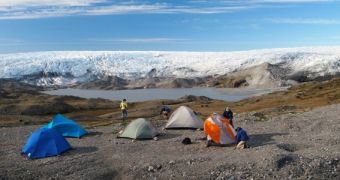An international team of investigators was recently able to determine that perfectly preserved landscapes exist, frozen in time, between kilometers of ice in Greenland. The regions in question can be found under the critically important Greenland Ice Sheet, the group discovered in a study supported by the US National Science Foundation (NSF).
The investigation was led by experts at the University of Vermont and included collaborators from the Idaho State University, the University of California in Santa Barbara (UCSB), and the Scottish Universities Environmental Research Center at the University of Glasgow. A paper detailing the findings was published in the April 17 online issue of the top journal Science.
According to the researchers, the landscapes frozen under the GIS are around three million years old. In other words, they are very likely to contain traces of organisms and complex animals that lived at the time, as well as an yet-unexplored treasure trove of data related to the chemical composition of the atmosphere and water at that time.
When ice forms, small air bubbles can get trapped within, storing clues on the amount of greenhouse gases in the atmosphere when the ice formed, if a volcano was erupting nearby, and so on. All this information is very important towards reconstructing our planet's climate history and, therefore, being able to predict its future.
The international science team arrived at these conclusions after carefully analyzing the chemical composition of silts recovered from the bottommost layers of an ice core. These are very long and very thin samples that are extracted from ancient ices. This particular one was around 3 kilometers (1.86 miles) long, the group reveals.
Based on their analysis, the researchers wrote in Science that “pre-glacial landscapes can remain preserved for long periods under continental ice sheets.” Previously, geologists believed that landscapes locked into place by advancing ices would get destroyed by erosion after a time, but this does not appear to be the case below the GIS.
Even during the warmest and longest interglacial periods, when global temperatures rise, the preserved areas are not exposed and suffer only minimal surface erosion. This means that they would make for very interesting study targets. Preliminary studies of the recovered slits indicate that Greenland was once worthy of its name, boasting green lands and a heavily forested landscape before the ices arrived.
“Rather than scraping and sculpting the landscape, the ice sheet has been frozen to the ground, like a giant freezer that's preserved an antique landscape,” says the lead author of the paper, expert Paul R. Bierman from the University of Vermont.

 14 DAY TRIAL //
14 DAY TRIAL //